Introduction
For natural reasons, it is extremely difficult to paint a complete picture of the history of padlocks in this gigantic country with its huge population. I spent two months traveling in the northern and southernmost parts of China, exploring ancient buildings and visiting museums of classical architecture, cultural museums and antique markets in hopes of finding evidence of the development of Chinese padlocks.
 |
| Chinese characters for the word padlock, two alternatives |
A doctoral dissertation in the field, defended by authors Hsing-Hui Huang and Hong-Sen Yan in 2004, provided valuable support. Although the paper is written in their native tongue, they have fortunately provided English summaries of some parts. The authors had analyzed box and animal-shaped padlocks – the type and shape with a shackle and ward springs, which is the primary focus of this article. The authors believe that “locks have been used in ancient China for several thousands of years. However, the historic records of Chinese locks are few and the literatures regarding design considerations are not available.”
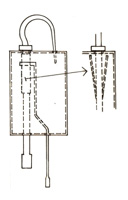 |
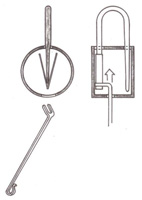 |
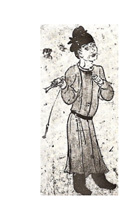 |
| Padlock from China, c. 10th C. Sketches by the author. |
Padlock from Norway, c. 10th C. Sketches by the author. |
A doorman with a key. Mural in Crown Prince Zhanghuai’s (654–684 AD) burial mound. Detail of a photo by an unknown photographer. From a guide book from the 1970s. |
As I see it, it appears that mechanical locks began being manufactured and used somewhat later in China than in Western Europe. They are based on the locks developed in the 2nd and 3rd centuries by Roman engineers and spread by the Roman Army to all parts of that giant empire. There are striking similarities between locks in China and in Scandinavia during the late Viking era (see the figures above). Both of these cultures were removed from direct influence by the Roman Empire. Many of the larger iron padlocks I have studied have an unmistakable character of 17th–19th century Arabic locks.
However, it is clear that padlocks with ward springs on the shackle have been used by emperors and wealthy officials from the Jin era (265–420 AD) on. But how did the first emperors arrive at the idea of using padlocks? Thieves have always existed, and wooden door beams have been used as simple but effective protection in China as long as doors have existed. This was particularly true of the gates to Chinese cities throughout history.
 |
| Padlock principle from the Tang Dynasty (618–907 AD). Sketch by the author. |
In those days, China was expanding westward through renewed contact with countries such as India and Iran. At the same time, Roman technology and developments had spread into those countries. Many influences found their way into China during the Tang Dynasty through Buddhism and trade, and were adapted to Chinese tastes. These imported elements of style are evident in grave goods from this era. Influences, impulses and technological concepts from the west flowed into China over long periods, particularly through trade along the 2000-year old east–west caravan road, Persia’s Royal Road. The route was later renamed the Silk Road by German professor of geography Ferdinand von Richthofen in the late 19th century. The road was one of the key links providing cultural contact between all the peoples along the way between Europe and Asia. The Silk Road stretched from the eastern part of the Mediterranean, through Baghdad, Hamadan, Kashi (Kashgar), Minghoshan (Dunhuang) and Xi’an (Changáng) in China. The route flourished during three periods, during the Han and Tang Dynasties and under the rule of Genghis and Kublai Khan.
Initially, padlocks were probably not used to protect riches, but simply because they were attractive, interesting status symbols.
When Kublai Khan ruled the Mongolian Empire from China in the latter half of the 13th century and on, he intensified contacts and trade with the west, and many westerners lived in the country for long periods during this time. Marco Polo from Venice lived at the court of Kublai Khan for 17 years, and may well have taught the ruler about how and why people used locks in his homeland.
As keys became more common, we see once again as in Northern Europe, that married women were made key bearers. On marriage, the woman took responsibility for the family’s property and wore the key in a prominent place as proof of her key power.
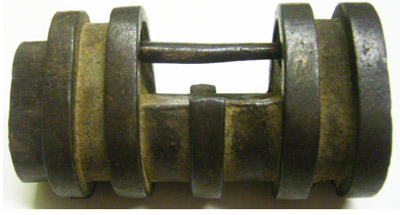 |
| Padlock cast of bronze, from the early Ming Dynasty, c. 1400. It has a shackle with double (4) ward springs. Photo by the author. |
During the Ming Dynasty (1368–1644) and later, new materials and shapes and more efficient techniques were used in building locks. At the same time, a primitive but proven type of wooden pin tumbler lock with two or three pins was also used in China. This was the same type of pin tumbler lock used all over Europe and in parts of Africa, but with roots in Ancient Egypt. Read about this kind of lock in the article on Locks of wood and iron.
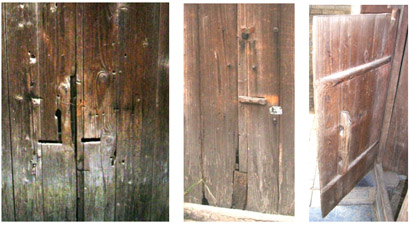 |
| Three doors from the old Ming city Yangmeizhan, 30 km NE of Nanning in Southern China, with “keyholes” through which the bar on the inside of the door is moved. The hinges of the doors consist of a wooden dowel at the top and bottom. Photos by the author. |
From the 17th century and on into modern day, we see more varieties of box-shaped padlocks and locks with gently curved bodies and inscriptions meant to bring good fortune. Alongside them, other types exist that are made of the same materials, but are shaped like people, animals, insects, musical instruments and other forms. All of these types of locks use a shackle with ward springs.
Some of the animal shapes are directly linked to the traditional figures of the Chinese zodiac. The question is whether these locks were simply decorative or if they were also practical.
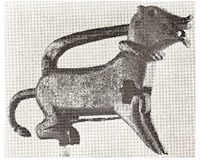 |
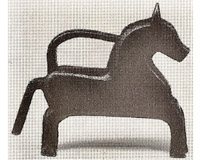 |
| Padlock from Seljuk, Iran, 12th C |
Padlock from Russia, 18th C |
|
Photos from Made of Iron, an exhibition catalogue dated 1966. |
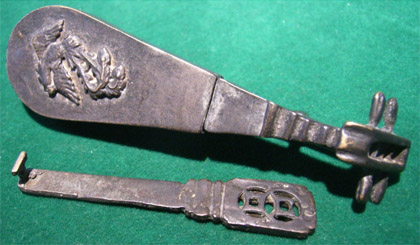 |
| Padlock in the shape of a Chinese string instrument. Photo by the author. |